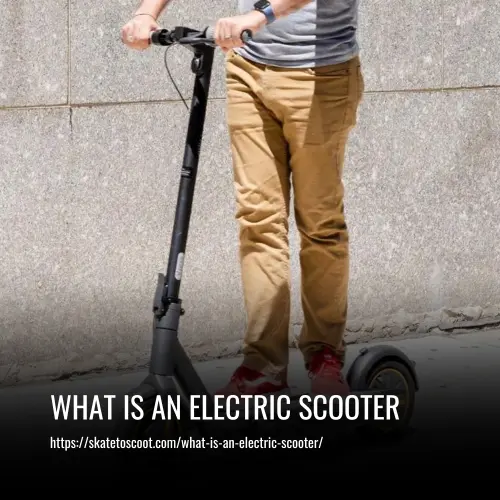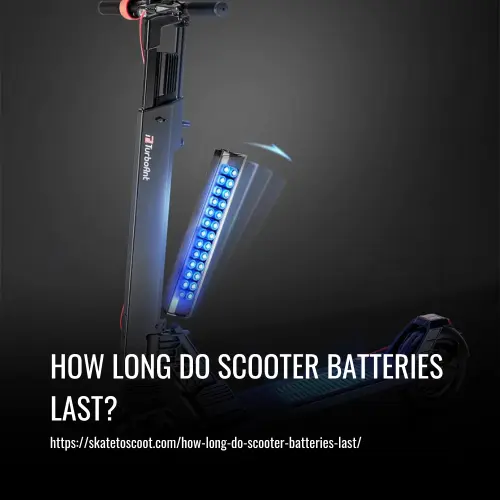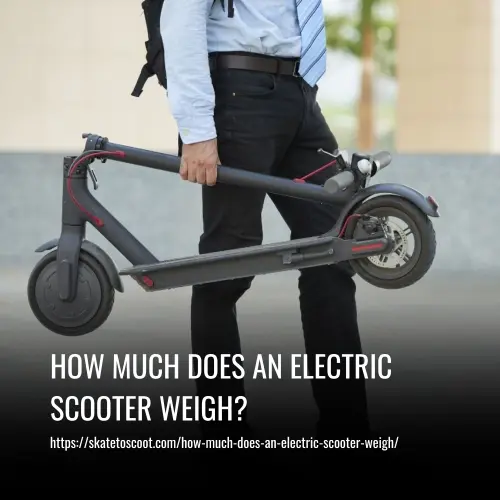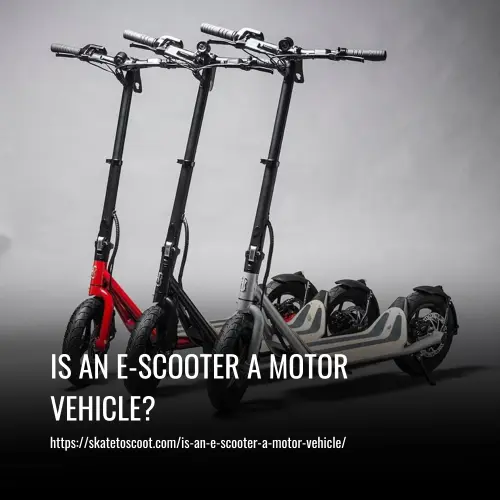As an Amazon Associate we earn from qualifying purchases.
An electric scooter is a battery-operated vehicle designed for people with low mobility. It provides a convenient and eco-friendly mode of transportation. Electric scooters are available in different designs and can have three or four wheels. They are equipped with rechargeable batteries that can run for about eight hours and cover 20-30 miles on a single charge.
Operating an electric scooter is simple, with an easy-to-use control console and advanced brake systems that ensure safe and comfortable stops. It is advisable to do thorough research to find the best electric scooter option based on specific needs and to check if insurance or Medicare covers the cost.

How Electric Scooters Work
An electric scooter consists of a battery, motor, throttle, and controller. When the rider twists the throttle on the handlebar, the controller signals the battery to supply energy to the motor. The motor, located on the wheel hub, uses this energy to rotate the gear and propel the scooter forward. Some models require a kick-off to engage the motor, while others can be operated solely using the handlebars.
The speed of the scooter is controlled by the throttle. It’s important to note that different electric scooter models may have slight variations in how their components work. Overall, electric scooters offer a convenient and eco-friendly mode of transportation.
The Benefits Of Using An Electric Scooter
Electric scooters have become increasingly popular in cities around the world. They offer numerous benefits that make them an attractive choice for urban transportation. Here are some of the key advantages of using an electric scooter:
1. Convenient, and Easy to Use
Electric scooters are an easy-to-use mode of transportation. They require little skill to operate, making them accessible to riders of all ages. Some models even come with added safety features like LED lights and robust braking systems to ensure a safe and comfortable ride.
2. Relatively Eco-Friendly
Electric scooters are an eco-friendly option for commuting. They produce zero emissions and require low amounts of electricity to operate. Compared to cars and SUVs, electric scooters are more energy-efficient and contribute to reducing carbon footprints.
3. Perfect for Short Distances
Electric scooters are ideal for short-distance travel. They are a convenient and affordable option for commuting to nearby destinations, such as offices, schools, or residential areas. They can also navigate through areas that cars and other vehicles cannot access.
4. Can Skip Traffic Jams
Electric scooters offer riders the advantage of avoiding traffic jams. Their compact size allows them to utilize bike lanes, walkways, and other paths that are traffic-free, making it easier and quicker to reach their destination.
5. Less Noise Pollution
Electric scooters produce minimal noise, creating less noise pollution compared to traditional vehicles. This makes them a preferred choice for those who value a quieter mode of transportation.
6. No Need for Permits or a License
Electric scooters typically do not require special licenses or permits to operate. They have lower speeds compared to gas-powered scooters and bikes, making them more accessible and suitable for younger riders as well.
7. Mobility for Those with Health Issues
Electric scooters provide increased mobility for individuals with health issues. They require minimal physical effort to operate, providing a convenient mode of transportation for those who have difficulty walking or using other means of transport.
The Cons of Electric Scooters
While electric scooters offer many benefits they do have certain drawbacks to consider.
1. Cost
Electric scooters can be more expensive than conventional scooters, particularly if they have advanced features like a long-range battery or a powerful motor. This higher cost may make them less accessible for some individuals.
2. Range
Most electric scooters have a limited range, which may not be suitable for long journeys or daily commuting. Users may need to plan their routes carefully and consider battery life to avoid being stranded without power.
3. Weight
Compared to conventional scooters, electric scooters can be heavier, which can make them more difficult to transport or store when not in use. This can be a significant inconvenience for users who need to carry their scooters up stairs or fit them into small spaces.
4. Charging
Electric scooters require regular charging to function properly. This can be a hassle if there are no charging stations nearby or if the scooter’s battery dies while in use. Users must plan their rides accordingly to ensure they have enough charge for their intended trips.
5. Maintenance
Compared to conventional scooters, electric scooters may require more frequent maintenance. This could include battery replacement or motor cleaning. This added maintenance can be time-consuming and costly, making it important for users to factor in these additional expenses.
6. Safety
Electric scooters can be faster and more powerful than conventional scooters, which can make them potentially more dangerous if not used responsibly. It is crucial for users to follow all safety instructions and regulations, including wearing helmets and obeying traffic laws, to mitigate the risks associated with electric scooter usage.
FAQs
A scooter is a small vehicle with a platform for the rider’s feet and a handlebar for steering. The rider propels it forward by pushing it off the ground with their feet. On the other hand, an electric scooter is powered by an electric motor, eliminating the need for the rider to use their muscles. Instead, the rider can simply press a button or use a throttle to move the scooter forward.
The lifespan of an electric scooter depends on factors such as usage and maintenance. With proper care, most electric scooters can last for several years. However, over time, the batteries that power electric scooters may start to lose their capacity, which can shorten the overall lifespan of the scooter.
The cost to charge an electric scooter can vary based on the size of the battery and the cost of energy in your area. Generally, though, the cost of charging an electric scooter is lower compared to refueling a gas-powered vehicle. Depending on the model and your local electricity prices, you can expect to pay a few cents to charge an electric scooter. In many cases, you can charge an electric scooter using a regular household socket, eliminating the need for additional equipment.
The lifespan of an electric scooter battery depends on various factors, including battery quality, scooter type, and usage. With regular use, an electric scooter battery can last for several years. Most electric scooters can travel between 10 and 15 miles on a single charge, and it typically takes 4 to 8 hours to fully recharge a drained battery. It’s important to refer to the manufacturer’s specifications or the user manual of your specific electric scooter model to determine its battery life.
If a person exceeds the weight limit of an electric scooter, it can lead to instability or even pose a danger to the rider. The scooter may not function properly, and in rare cases, it can stop working or break. To ensure safety and proper operation, it’s crucial to check the weight limit of the electric scooter before using it and make sure you do not exceed the maximum weight limit specified by the manufacturer.
The future of electric scooters depends on various factors and external variables. However, modern electric scooters are indeed a great way to save energy while running daily errands. They offer a more eco-friendly alternative to conventional scooters or other modes of transportation.
Modern electric scooters can travel anywhere from 15 to 50 miles on a single charge, depending on the size and efficiency of the internal battery. Factors such as road conditions and the rider’s weight can also affect the distance an electric scooter can travel.
The legality of riding electric scooters depends on local laws and regulations. For example, in California, riding electric scooters on the sidewalk is prohibited. Riders are usually required to use bike lanes or similar designated areas. Some states and municipalities may also require riders to have a valid driver’s license and wear a helmet at all times. It’s important to familiarize yourself with the specific laws and regulations in your area before riding an electric scooter.
Conclusion
In conclusion, electric scooters have become a popular mode of transportation for many people. They provide a convenient and eco-friendly option for commuting short distances or running errands. With their powerful motors and larger batteries, electric scooters offer a comfortable ride and the ability to tackle different types of road conditions.
Whether you’re cruising on a flat road or navigating bumpy terrains, electric scooters with pneumatic or solid tires and various types of suspension systems can adapt to your needs. Additionally, electric scooters often come equipped with features such as cruise control and regenerative braking, making them even more efficient and user-friendly.
However, it’s important to follow local laws and regulations when riding electric scooters, ensuring the safety of both riders and pedestrians. Overall, electric scooters are a versatile and practical option for those looking for an alternative mode of transportation that is both efficient and environmentally friendly.
Amazon and the Amazon logo are trademarks of Amazon.com, Inc, or its affiliates.



